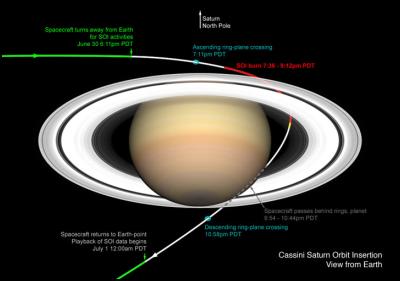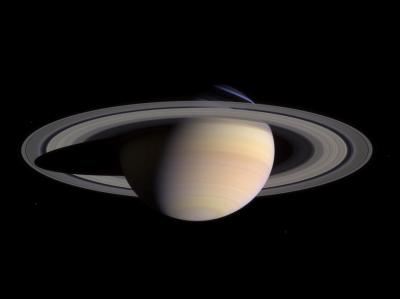Images: Cassini Spacecraft at Saturn's Doorstep
Cassini Spacecraft at Saturn's Doorstep
June 29, 2004
(Source: Jet Propulsion Laboratory)
MEDIA RELATIONS OFFICE
JET PROPULSION LABORATORY
CALIFORNIA INSTITUTE OF TECHNOLOGY
NATIONAL AERONAUTICS AND SPACE ADMINISTRATION
PASADENA, CALIF. 91109 TELEPHONE (818) 354-5011
Saturn is now a day away for the Cassini spacecraft, a seasoned traveler that began its journey nearly seven years ago.
On June 30 at 7:36 p.m. Pacific Time (10:36 p.m. EDT), Cassini will begin executing a series of commands to enter orbit around the ringed planet. The spacecraft will fire its main engine for a crucial 96 minutes to slow down and be captured in orbit about Saturn.
Besides launch, orbit insertion is the next most critical part of the mission. "Everything has to go just right. The burn must occur for all 96 minutes, the turns must occur at the right time, the computers must keep the sequence going even in the event something unexpected should happen," said Robert T. Mitchell, program manager for the Cassini-Huygens mission at NASA's Jet Propulsion Laboratory, Pasadena, Calif. "The spacecraft has been programmed to continue even in the event of an emergency. With a one-way light time of 1 hour and 24 minutes, we had to teach the spacecraft to take care of itself. We don't want Cassini to call home if a problem arises, we want it to keep going. That is precisely what we've told the spacecraft: Don't stop, keep going until you've put in all 96 minutes of burn," he said.
During the orbit insertion, Cassini will fly closer to Saturn than at any other time during the spacecraft's planned four-year tour of Saturn. This provides an unprecedented opportunity to study the planet and rings at close range. It will pass approximately 20,000 kilometers (12,427 miles) above Saturn's cloud tops, closer than any other spacecraft in history. It will also be flying about 10 times closer to the rings than at any other point in the mission
Cassini carries 12 instruments that will study the planet, rings and moons in extensive detail. Riding aboard Cassini is a second spacecraft, the Huygens probe, built by the European Space Agency. It carries half a dozen instruments that will study Titan, Saturn's largest moon, a prime target for both Cassini and the Huygens probe. Titan is the only moon in the solar system to have a dense atmosphere and resembles the early Earth in deep freeze.
"In a sense, Cassini and the Huygens probe are like time machines that will take us back to examine a world we've never seen before, a world that may resemble what our own world was like 4.5 billion years ago," said Dr. Jean-Pierre Lebreton of the European Space Agency, who is mission manager and project scientist for the Huygens probe.
Eighty-five minutes before the engine burn, Cassini will rotate to point its main antenna dish forward. The Italian-built antenna, 4 meters (13 feet) in diameter, will offer shielding against dust particles the spacecraft may hit as it crosses a gap in the rings. The spacecraft will continue transmitting a monotone "carrier" signal with a secondary antenna for tracking from Earth. Cassini will pass twice through a known gap between the F and G rings, first while ascending shortly before the burn, then while descending shortly after the burn.
The engine burn will slow the spacecraft by 626 meters per second (1,400 miles per hour). Five science instruments will be on during the burn, and others will be used shortly after the engine cuts off. The magnetometer will measure the strength and direction of the magnetic field to understand the physics of Saturn's magnetic dynamics. Lightning may also be detected. Another instrument will provide a record of the dust hits as the spacecraft flies through the ring plane. These observations may tell scientists the size of these tiny particles and the thickness of that ring region. The remote sensing instruments will assess the rings' composition, temperature, and structure. Then the spacecraft will be oriented for the outbound ring plane crossing. After crossing the ring plane in the descending mode, Cassini will look back at the sunlit face of the rings to take more data before turning to Earth to transmit its data.
"Should something happen during the burn, the science sequence will stop," said Dr. Dennis Matson, project scientist for the Cassini-Huygens mission at JPL. "We are prepared to live with this outcome. Getting into orbit is the priority. Getting the science is extra credit."
The Cassini-Huygens mission is a cooperative project of NASA, the European Space Agency and the Italian Space Agency. The Jet Propulsion Laboratory, a division of the California Institute of Technology in Pasadena, manages the Cassini-Huygens mission for NASA's Office of Space Science, Washington, D.C. JPL designed, developed and assembled the Cassini orbiter.
For the latest images and more information about the Cassini-Huygens mission, visit http://www.nasa.gov/cassini .

Click for big version
A Guide to Saturn Orbit Insertion
June 28, 2004
Image Credit:
NASA/JPL/Space Science Institute
After nearly seven years of space travel, the Cassini-Huygens spacecraft will arrive at Saturn on June 30. In a maneuver called orbit insertion, Cassini will slow itself down to enter into orbit around the ringed planet. NASA TV will cover JPL mission control as it communicates with the spacecraft during this critical phase of the mission.
Highlights of Orbit Insertion:
(All
times are approximate and listed in Pacific Time)
(NOTE FOR NZ READERS: US PDT is 20 hours behind us… i.e. 6.10pm on June 30th is 2.10pm on July 1st in NZ)
6:10 p.m.
PDT - Spacecraft turns so its high-gain antenna can shield
the craft from particles as it crosses Saturn's ring
plane.
7:36 p.m. PDT - Engine begins burn, which will
slow spacecraft down so it can be captured by Saturn's
gravity. Burn lasts approximately 96 minutes.
8:54 p.m.
PDT - Cassini captured in Saturn orbit.
9:03 p.m. PDT -
Closest approach to Saturn of entire mission: 19,980
kilometers (12,400 miles) from Saturn's cloud tops.
9:12
p.m. PDT to
9:22 p.m. PDT - Engine burn ends.
9:35
p.m. PDT - Spacecraft begins to take pictures of Saturn's
rings.
*If everything proceeds as planned, first images are expected July 1, at approximately 5 a.m. PDT.
The Cassini-Huygens mission is a cooperative project of NASA, the European Space Agency and the Italian Space Agency. The Jet Propulsion Laboratory, a division of the California Institute of Technology in Pasadena, manages the Cassini-Huygens mission for NASA's Office of Space Science, Washington, D.C. The Cassini orbiter and its two onboard cameras were designed, developed and assembled at JPL. The imaging team is based at the Space Science Institute, Boulder, Colo.

Click for big version
Image Credit:
NASA/JPL/Space Science Institute
June 29, 2004
Saturn's peaceful beauty invites the Cassini spacecraft for a closer look in this natural color view, taken during the spacecraft's approach to the planet. By this point in the approach sequence, Saturn was large enough that two narrow angle camera images were required to capture an end-to-end view of the planet, its delicate rings and several of its icy moons. The composite is made entire from these two images.
Moons visible in this mosaic: Epimetheus (116 kilometers, 72 miles across), Pandora (84 kilometers, 52 miles across) and Mimas (398 kilometers, 247 miles across) at left of Saturn; Prometheus (102 kilometers, 63 miles across), Janus (181 kilometers, 113 miles across) and Enceladus (499 kilometers, 310 miles across) at right of Saturn.
The images were taken on May 7, 2004 from a distance of 28.2 million kilometers (17.6 million miles) from Saturn. The image scale is 169 kilometers (105 miles) per pixel. Moons in the image have been brightened for visibility. The Cassini-Huygens mission is a cooperative project of NASA, the European Space Agency and the Italian Space Agency. The Jet Propulsion Laboratory, a division of the California Institute of Technology in Pasadena, manages the Cassini-Huygens mission for NASA's Office of Space Science, Washington, D.C. The Cassini orbiter and its two onboard cameras were designed, developed and assembled at JPL. The imaging team is based at the Space Science Institute, Boulder, Colo.
For more information about the Cassini-Huygens mission visit, http://saturn.jpl.nasa.gov and the Cassini imaging team home page, http://ciclops.org .


 Ferry Holdings Limited: Decommissioning Of The Aratere Ferry
Ferry Holdings Limited: Decommissioning Of The Aratere Ferry Broadcasting Standards Authority: Inaccurate 1News Reporting On Football Violence Breached Broadcasting Standards
Broadcasting Standards Authority: Inaccurate 1News Reporting On Football Violence Breached Broadcasting Standards Better Taxes for a Better Future: $1b Cut In Budget Operating Allowance ‘Unnecessary And Damaging’
Better Taxes for a Better Future: $1b Cut In Budget Operating Allowance ‘Unnecessary And Damaging’ Transport Well NZ: Transport Well New Zealand Charitable Trust - A Vision For The Entire Sector
Transport Well NZ: Transport Well New Zealand Charitable Trust - A Vision For The Entire Sector KiwiRail: Auckland Rail Network Reopens After Successful Upgrades
KiwiRail: Auckland Rail Network Reopens After Successful Upgrades ChargeNet: EV infrastructure co-funding model welcomed
ChargeNet: EV infrastructure co-funding model welcomed